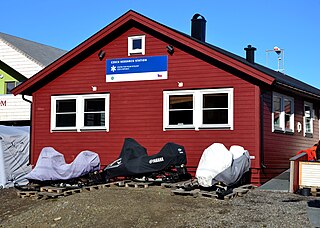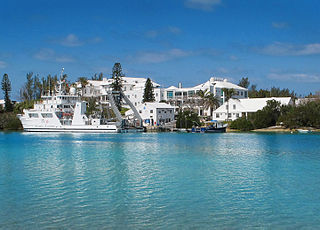Related Research Articles

Computational biology refers to the use of data analysis, mathematical modeling and computational simulations to understand biological systems and relationships. An intersection of computer science, biology, and big data, the field also has foundations in applied mathematics, chemistry, and genetics. It differs from biological computing, a subfield of computer science and engineering which uses bioengineering to build computers.
Ecoinformatics, or ecological informatics, is the science of information in ecology and environmental science. It integrates environmental and information sciences to define entities and natural processes with language common to both humans and computers. However, this is a rapidly developing area in ecology and there are alternative perspectives on what constitutes ecoinformatics.

Research stations are facilities where scientific investigation, collection, analysis and experimentation occurs. A research station is a facility that is built for the purpose of conducting scientific research. There are also many types of research stations including: biological field stations, space stations etc. Research station sites might include remote areas of the world, oceans, as well as outer space, such as the International Space Station. Biological research stations developed during a time of European colonization and imperialism where naturalists were employed to conduct observations on fauna and flora. Today, the discipline is represented by a number of organizations which span across multiple continents. Some examples include: the Organization of Biological Field Stations and the Organization for Tropical Studies.

Environmental education (EE) refers to organized efforts to teach how natural environments function, and particularly, how human beings can manage behavior and ecosystems to live sustainably. It is a multi-disciplinary field integrating disciplines such as biology, chemistry, physics, ecology, earth science, atmospheric science, mathematics, and geography.
Joan Roughgarden is an American ecologist and evolutionary biologist. She has engaged in theory and observation of coevolution and competition in Anolis lizards of the Caribbean, and recruitment limitation in the rocky intertidal zones of California and Oregon. She has more recently become known for her rejection of sexual selection, her theistic evolutionism, and her work on holobiont evolution.
The San Diego State University College of Sciences is a college of San Diego State University. Comprising eight departments and various specialties, the college offers bachelor's, master's and doctoral degrees, as well as curricula for pre-professional students in medicine, veterinary medicine and dentistry.
The National Center for Ecological Analysis and Synthesis (NCEAS) is a research center at the University of California, Santa Barbara, in Santa Barbara, California. Better known by its acronym, NCEAS (pronounced “n-seas”) opened in May 1995. Funding for NCEAS is diverse and includes supporters such as the U.S. National Science Foundation, the State of California, and the University of California, Santa Barbara.

Omora Ethnobotanical Park is a protected area of Chile located 4 km (2 mi) west of Puerto Williams on Navarino Island in the extreme southern Magellan and Chilean Antarctica Region. The Omora Park is a research, education and conservation center for the Cape Horn Biosphere Reserve. The park itself includes a representative variety subantarctic flora open to the public for formal and information education. Within its boundaries, one can find deciduous forests and evergreen broadleaf forests, as well as bogs and high-Andean ecosystems and diverse mosses, lichens and liverworts.
The College of Biological Sciences (CBS) is one of seven freshman-admitting colleges at the University of Minnesota. Established in 1965, the College of Biological Sciences is located on both the Minneapolis and the St. Paul campuses. Faculty in the college conduct research on a wide range of topics that contribute to understanding of the environment, human health and basic biology. Dr. Saara J. DeWalt is the current dean of the college.

The ASU Bermuda Institute of Ocean Sciences is a non-profit marine science and education institute located in Ferry Reach, St. George's, Bermuda and affiliated with the Julie Ann Wrigley Global Futures Laboratory at Arizona State University. The institute, founded in 1903 as the Bermuda Biological Station, hosts a full-time faculty of oceanographers, biologists, and environmental scientists, graduate and undergraduate students, K-12 groups, and Road Scholar groups. ASU BIOS's strategic mid-Atlantic Ocean location has at its doorstep a diverse marine environment, with close proximity to deep ocean as well as coral reef and near shore habitats.
The Anheuser–Busch Coastal Research Center is a biological field station located in Oyster, Virginia that is operated by the University of Virginia. It is a member of the Organization of Biological Field Stations (OBFS). It serves as the research home for the Virginia Coast Reserve Long-Term Ecological Research Program. A new $2.5 million laboratory and housing facility was dedicated in on August 26, 2006.

Ricardo Rozzi is a Chilean ecologist and philosopher who is professor at the University of North Texas and the Universidad de Magallanes (UMAG). His research combines the two disciplines through the study of the interrelations between the ways of knowing and inhabiting the natural world, proposing a dynamic continuous reciprocal feedback between both domains.

National Institute for Materials Science is an Independent Administrative Institution and one of the largest scientific research centers in Japan.
Miguel Altieri is a Chilean born agronomist and entomologist. He is a Professor of Agroecology at the University of California, Berkeley in the Department of Environmental Science, Policy and Management.
The Extended Evolutionary Synthesis (EES) consists of a set of theoretical concepts argued to be more comprehensive than the earlier modern synthesis of evolutionary biology that took place between 1918 and 1942. The extended evolutionary synthesis was called for in the 1950s by C. H. Waddington, argued for on the basis of punctuated equilibrium by Stephen Jay Gould and Niles Eldredge in the 1980s, and was reconceptualized in 2007 by Massimo Pigliucci and Gerd B. Müller.

Ivette Perfecto is an ecologist and professor at the University of Michigan. Her work focuses on complex ecosystem dynamics and the application of ecological theories to agricultural systems.
Carmen Cid is a Latin American urban wetland ecologist and faculty member at Eastern Connecticut State University. She focuses on ecology education and diversity in science. Cid is a fellow of the Ecological Society of America (ESA)
Jessica Gurevitch is a plant ecologist known for meta-analysis in the fields of ecology and evolution.
Biological stations are research stations specializing in biology and ecology. Their size and purpose varies, mainly regarding research, conservation and education. They are located in all biomes, including aquatic ones. Students, other scientists and the public are the aim public of these sites. Many are focused on protected ecosystems. Data from 157 field stations in 56 countries show that their presence improved habitat quality and reduced hunting rates and spatial analyses support field station presence as reducing deforestation.
References
- ↑ McNulty, Stacy A.; White, David; Hufty, Mary; Foster, Paul (2017). "The Organization of Biological Field Stations at Fifty". The Bulletin of the Ecological Society of America. 98 (4): 359–373. doi: 10.1002/bes2.1349 . hdl: 2027.42/138850 . ISSN 2327-6096.
- ↑ Brunt, James W.; Michener, William K. (June 2009). "The Resource Discovery Initiative for Field Stations: Enhancing Data Management at North American Biological Field Stations". BioScience. 59 (6): 482–487. doi:10.1525/bio.2009.59.6.6. ISSN 1525-3244. S2CID 86338774.
- ↑ Tydecks, Laura; Bremerich, Vanessa; Jentschke, Ilona; Likens, Gene E.; Tockner, Klement (February 1, 2016). "Biological Field Stations: A Global Infrastructure for Research, Education, and Public Engagement". BioScience. 66 (2): 164–171. doi: 10.1093/biosci/biv174 . ISSN 0006-3568.
- ↑ Klug, Michael J.; Hodder, Janet; Swain, Hilary (February 11–12, 2002). "The Role of Biological Field Stations in Education and Recruitment into the Biological Sciences. Report of a Workshop, "Education and Recruitment into the Biological Sciences: Potential Role of Field Station and Marine Laboratories", Washington, D.C.". CiteSeerX 10.1.1.575.2508 .
- ↑ American Institute of Biological Sciences (2010). Topics in biological field stations. University of California Press for the American Institute of Biological Sciences. ISBN 978-0-9817130-4-5. OCLC 759120278.